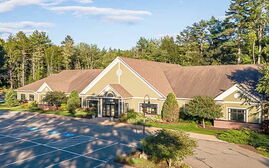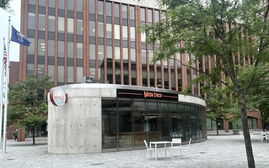Boulos report: Portland-area real estate market won't succumb to history
 Courtesy / WEX
WEX's move to the Portland peninsula has had an impact on the office market in the area, the Boulos Co. 2020 market report says.
Courtesy / WEX
WEX's move to the Portland peninsula has had an impact on the office market in the area, the Boulos Co. 2020 market report says.
While history says a bust is coming soon, the Portland-area real estate market this year will continue to be strong, Drew Sigfridson, managing director of The Boulos Co., said in the company's just-released annual market report.
Sigfridson predicts that, despite some cautionary signs, 2020 will continue to ride the wave of a resurgence on the Portland peninsula and a wider-reaching construction boom.
Boulos closed out 2019 as the most successful year in its history, he said, with more than $420 million in sale and lease transactions.
"Upcoming projects suggest significant demand and business growth in multiple sectors —particularly in medical, senior housing, professional services and light industrial," Sigfridson said in the introduction of the 32-page report compiled by the company's staff and brokers.
Challenges will continue to include a lack of good-quality office and industrial space, which makes it difficult for growing companies to find an adequate location. "While interest rates and demand for new commercial space remain strong, construction costs and the tight construction labor market continue to be limiting factors impacting new construction starts," he said. "Investment product remains in high demand, and a lack of available product continues to inflate property values."
"Despite these challenges, the forecast isn’t negative," he said. "In fact, greater Portland is experiencing a resurgence and construction boom. On the peninsula, we are witnessing hotel, condominium, and office construction. Current projects under development for Sun Life, WEX, and Covetrus will add an additional 330,000 square feet of commercial space on the eastern waterfront."
The region is also riding the wave of new mixed-use trends with the 500-acre The Downs mixed-use development in Portland and the Rock Row development in Westbrook.
Some of the general insights are:
Office space
The overall office vacancy rate in greater Portland increased to 6.7% in 2019 after a 10-year decline, hitting the lowest point with 4.8% in 2018. Most of the increase, according to broker Nate Steven is because of development in the suburban market. The company's survey included more than 12 million square feet of office space in 350 Class A and B buildings in the area.
While available space in submarkets outside Portland's downtown increased from 3.78% to 8.75%, because the market is so small, 80% of the added vacant square footage came from just a couple buildings, including UNUM’s consolidation into two of their three outer Congress Street buildings and WEX’s move from South Portland to downtown Portland.
Demand still continued to grow downtown in 2019, with only 10,000 square feet of Class A space available across 25 buildings — a 0.4% vacancy rate "and the tightest Class A market since 2001," the report says. Available Class B office space also decreased in 2019 to a rate of 7.72%, and according to Stevens, less than a third of it is in modern or recently renovated buildings.
In 2020, as new buildings go up downtown, "shadow space" will become the watchword. New construction, like the 172,000-square-foot Covetrus building on Hancock Street, means that a lot of space currently occupied by tenants who have signed a lease elsewhere will become available this year.
A need for medical office space means that, with only three small vacancies across 56 medical buildings throughout greater Portland, many looking for medical office space are building it.
"Still, this is a sector where landlords need to keep their properties fresh and renovated to keep their tenants — even in times of low vacancy," the report says. High construction costs are making that difficult for landlords, and so some Class A tenants are building new space.
Capital markets
Capital markets have had "an impressive 10-year run," said Chris Paszyc, managing partner. But some are questioning if the "unending flow of investor capital into commercial real estate" will continue.
Nationally, there is a growing consensus that the commercial real estate market has peaked and is now experiencing a deceleration, Paszyc said. "Given healthy [commercial real estate] fundamentals and accelerating construction costs keeping the new supply in check, however, indications are we should experience a soft landing and perhaps stave off a recession altogether."
Locally, that means Maine's traditionally stable market will keep plugging along. "Provided we see steady employment statistics, and capital is available, we expect continued strong demand for investment property statewide," he said. "While interest rates have decreased over 2019, cap rates were essentially unchanged in most markets and sectors."
Of the Boulos' more than $420 million in transactions in 2019, more than $100 million were termed investment transactions. The office sector accounted for $101 million of the overall total.
"There will be more investment product available than in previous years to satisfy demand," he said. "We expect robust activity into the first and second quarter of 2020 as several investment properties are coming to market to capitalize on late-cycle market dynamics."
Industrial space
The greater Portland industrial market in 2019 "continued to solidify itself as one of the most sought after investments in the region," said John Meador, associate broker. He doesn't expect the 2.5% vacancy rate in the Portland area to change much, as construction costs, lack of inventory and high demand drive the market.
"Strong fundamentals and a national shift in consumer tendencies have resulted in an increased buyer/tenant pool within secondary markets, as well as a deal-making environment that heavily favors industrial landlords and sellers."
Industrial users, with construction costs increasing as much as 30% year over year n some instances, have to decide whether to "renew in place and make it work” through significant investments in the space or move into one of the market’s few turnkey build-to-suit solutions and face a 30% to 50% overall increase in rent.
The Portland area, as much of New England, "has hit an inflection point," Meador said. Much of the industrial space is user-owned, eliminating significant square footage from the 19 million square foot market. And remaining “leasable” buildings don't meet tenant needs and "are quickly becoming functionally obsolete."
On top of it, land that offers a suitable location and reasonable construction economics for industrial product is diminishing.
"We expect the vacancy rate to remain between 2.5% to 3.0% for the foreseeable future," he said.
The demand side, meanwhile, will remain extremely strong as organic growth within the Maine industrial sector continues, "and as out-of-market users that once questioned the validity this market will formally expand their operations into the greater Portland region." Though even that comes with a caveat.
"Much of the latter user base, however, requires a minimum clear height, column spacing, and loading dock ratio that the majority of existing buildings in the market can’t accommodate," he said.











0 Comments